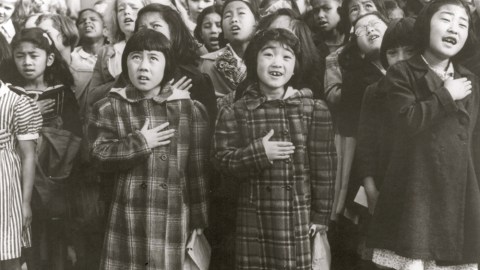The socialist roots of the Pledge of Allegiance

Image source: Buyenlarge / Getty Images
When studying history one must avoid inserting the present into the past. Many humans fail miserably at this task. Where you are today — your beliefs, your ideological system, your hopes —easily slips into your conception of what has already happened. This psychological phenomenon is most readily evident in religion, though politics is not far behind. Throughout American history the two are often indistinguishable.
I still recall the discomfort of mouthing the Pledge of Allegiance every morning for innumerable years, so much so that the words roll as easily from my tongue today as when I last recited it in high school 23 years ago. The procedure was simply part of getting through home room to first period; the words consciously failed to have any effect after the age of six or seven, and even then, it was more something you had to do rather than something you understood, even if certain teachers stressed its importance. The pledge’s abstract nature, at least on young minds, gels well with our country’s romanticized narcissism.
I’m sure at some point we learned that the pledge was written by a minister named Francis Bellamy, though I doubt, in suburban New Jersey, that we were informed he was an avowed socialist. Even today many Americans know the words ‘under God’ were added a half-century after he penned his pledge in 1892. More interestingly, he didn’t include the phrase “United States of America.” He simply wrote “my flag.”
Princeton history professor Kevin M Kruse unearths this story in his book, One Nation Under God: How Corporate America Created Christian America. Bellamy, Kruse writes, organized a series of celebrations catalyzing a movement for the inclusion of flags in public schools nationwide. For him, the symbol of the flag was the relevant focus; a salute was of little concern.
When a colleague could not produce the coincident pledge, Bellamy knocked it out in roughly two hours. It read as follows:
I pledge allegiance to my Flag and to the Republic for which it stands — one Nation indivisible — with Liberty and Justice for all.
Bellamy’s pledge wouldn’t catch on nationally until after World War I, as a number of other hopefuls had penned their praises for the nation as well. His real hope rested in the last five words: economic and social equality. Thirty years later a more conservative Bellamy offered up his pledge again, dismayed by waves of immigration bringing cheap labor into America’s workforce. As a way of demanding their allegiance, the pledge was updated to “the flag of the United States” in 1923, with “of America” thrown in a year later.
The pledge was finally approved by Congress in 1945. Even at that late date, there was no sign of a creator. The previous century had seen Revivals and the ideological Manifest Destiny, but in national politics a secular tone persisted. Then the emergence of a Christian libertarian movement, inspired by the merging of capitalism and Christianity two decades prior, began to dominate public opinion. In the midst of anti-Communism fervor the term “under God” officially slid into the vernacular thanks to a devout President Eisenhower in June 1954.
Today’s “Golden Age of America” mythos, one championed mostly on the Right, points to the ’50s as the modern Eden our republic is desperately trying to claw its way back to. Without listing a litany of reasons this illusion has transpired, the ’50s truly were a time when religious fever captured the widespread imagination. A corporate-driven series of initiatives allowed the government to praise its imagined deity on a number of products: money, stamps, and, with another updating of Bellamy’s pledge, into the minds of children everywhere. This religious deluge was made possible by a whirlwind of fear and vitriol whipped up by proselytizing priests sanctioned by powerful politicians stoking the flames of fear of boogiemen: communism, socialism, and foreigners.
Oh, how times don’t change.
Secularism has itself been revived, but the unconscious imprint of these strategies remains embedded in our psyches — the reason I can recall the exact cadence of Bellamy’s pledge all these years later. It’s at least slightly hopeful that Bernie Sanders has removed a smidgeon of the stigma of socialism (Google searches for the term have surged), but somehow religious boogeyman echo from that era in the form of anti-abortion legislation, assisted suicide opposition, creation science, and on occasion, school prayer.
A newer layer is emerging, though. The tone of this election season is not revolving around religion as much as projected. Sanders has unapologetically stuck by his agnosticism, while Hillary Clinton throws out mega-church praise: fluffy and tingly without much doctrinal dogmatism. We can only imagine how flummoxed the ultra-religious Ted Cruz and Marco Rubio must be watching their votes go to a man who can’t even pronounce the name of a popular biblical book correctly.
As Kruse writes regarding the government choosing “In God We Trust” as the nation’s first official motto over the more inclusive, “E Pluribus Unum,”
The concept of unity from diversity could not compete with that of unity from divinity.
Unity seems far from the spotlight in this campaign cycle, at least as far as the media is concerned. The lasting influence of the corporate-sponsored religion Kruse eloquently details in his enlightening yet frightening book remains firm in our national imagination. Yet the symbols on our dollars are useless if not enough citizens have those dollars. To contemplate our spiritual temperament is to investigate our economic predicament. This is, sadly, by design—powerful men have long exploited our brain’s penchant for the metaphysical to bolster their own success. As it is, no divinity is going to slow this process anytime soon.
—
Derek Beres is a Los Angeles-based author, music producer, and yoga/fitness instructor, currently working on his new book, The Valencia Filter. Stay in touch @derekberes.





